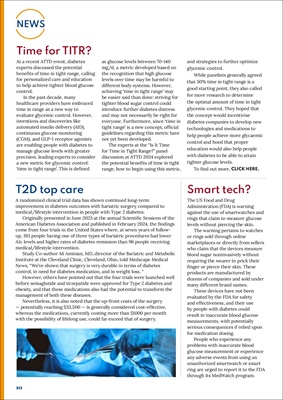
10
NEWS
Time for TITR?
At a recent ATTD event, diabetes
experts discussed the potential
benefits of time in tight range, calling
for personalized care and education
to help achieve tighter blood glucose
control.
In the past decade, many
healthcare providers have embraced
time in range as a new way to
evaluate glycemic control. However,
inventions and discoveries like
automated insulin delivery (AID),
continuous glucose monitoring
(CGM), and GLP-1 receptor agonists
are enabling people with diabetes to
manage glucose levels with greater
precision, leading experts to consider
a new metric for glycemic control:
'time in tight range'. This is defined
as glucose levels between 70-140
mg/d, a metric developed based on
the recognition that high glucose
levels over time may be harmful to
different body systems. However,
achieving 'time in tight range' may
be easier said than done: striving for
tighter blood sugar control could
introduce further diabetes distress
and may not necessarily be right for
everyone. Furthermore, since 'time in
tight range' is a new concept, official
guidelines regarding this metric have
not yet been developed.
The experts at the "Is It Time
for Time in Tight Range?" panel
discussion at ATTD 2024 explored
the potential benefits of time in tight
range, how to begin using this metric,
and strategies to further optimize
glycemic control.
While panelists generally agreed
that 50% time in tight range is a
good starting point, they also called
for more research to determine
the optimal amount of time in tight
glycemic control. They hoped that
the concept would incentivise
diabetes companies to develop new
technologies and medications to
help people achieve more glycaemic
control and hoed that proper
education would also help people
with diabetes to be able to attain
tighter glucose levels.
To find out more, CLICK HERE.
Smart tech?
The US Food and Drug
Administration (FDA) is warning
against the use of smartwatches and
rings that claim to measure glucose
levels without piercing the skin.
The warning pertains to watches
or rings sold through online
marketplaces or directly from sellers
who claim that the devices measure
blood sugar noninvasively without
requiring the wearer to prick their
finger or pierce their skin. These
products are manufactured by
dozens of companies and sold under
many different brand names.
These devices have not been
evaluated by the FDA for safety
and effectiveness, and their use
by people with diabetes could
result in inaccurate blood glucose
measurements, with potentially
serious consequences if relied upon
for medication dosing.
People who experience any
problems with inaccurate blood
glucose measurement or experience
any adverse events from using an
unauthorized smartwatch or smart
ring are urged to report it to the FDA
through its MedWatch program.
T2D top care
A randomized clinical trial data has shown continued long-term
improvement in diabetes outcomes with bariatric surgery compared to
medical/lifestyle intervention in people with Type 2 diabetes.
Originally presented in June 2023 at the annual Scientific Sessions of the
American Diabetes Association and published in February 2024, the findings
come from four trials in the United States where, at seven years of followup, 193 people
having one of three types of bariatric procedures had lower
A1c levels and higher rates of diabetes remission than 96 people receiving
medical/lifestyle intervention.
Study Co-author Ali Aminian, MD, director of the Bariatric and Metabolic
Institute at the Cleveland Clinic, Cleveland, Ohio, told Medscape Medical
News, "We've shown that surgery is very durable in terms of diabetes
control, in need for diabetes medication, and in weight loss. "
However, others have pointed out that the four trials were launched well
before semaglutide and tirzepatide were approved for Type 2 diabetes and
obesity, and that these medications also had the potential to transform the
management of both these diseases.
Nevertheless, it is also noted that the up-front costs of the surgery
- potentially reaching $33,500 - is generally considered cost-effective,
whereas the medications, currently costing more than $1000 per month
with the possibility of lifelong use, could far exceed that of surgery.